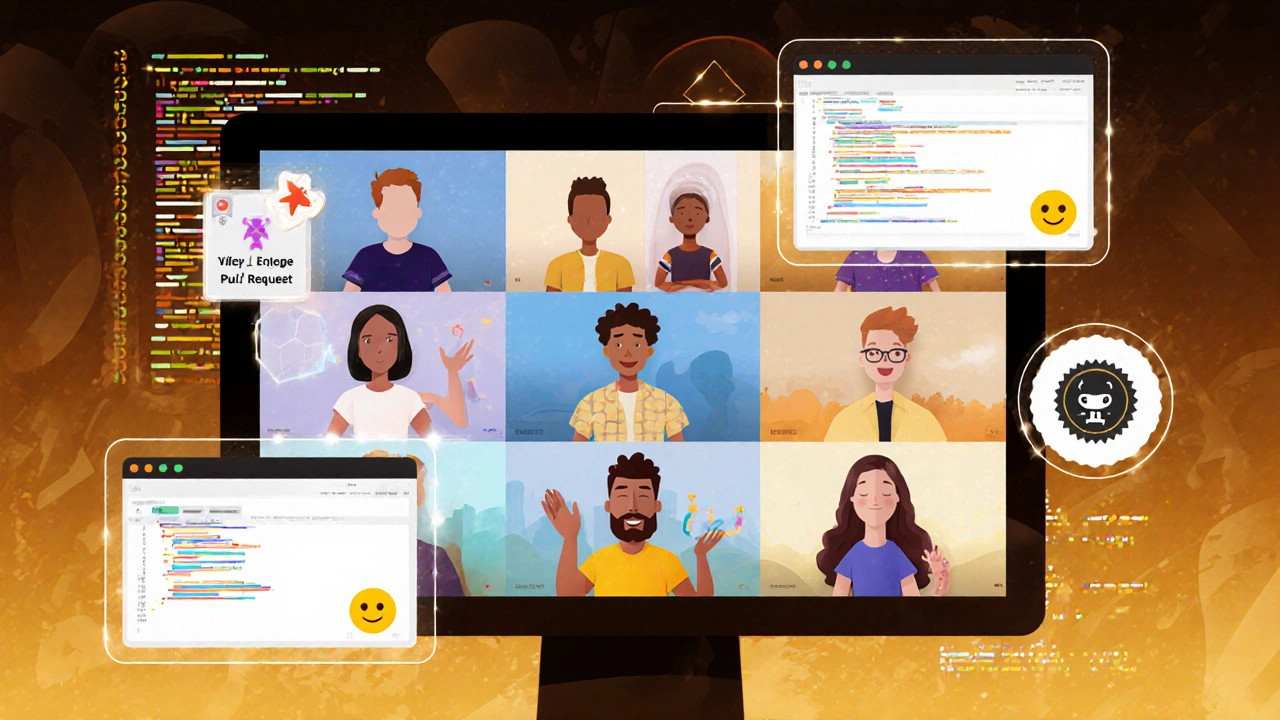Self-Taught Coding Path Planner
Goal:
Preferred Language:
Approach:
Recommended Resources:
Weekly Milestone Tracker:
Suggested Daily Routine:
- 5 min: Review previous code
- 15 min: Online platform exercise
- 20 min: Book reading
- 15 min: Personal project work
- 5 min: Community interaction
Wondering if you can become a programmer without stepping into a classroom? Absolutely-you can. The key is treating coding like any other skill: pick the right tools, set a realistic routine, and keep building real‑world stuff. Below you’ll find a step‑by‑step roadmap that turns the vague idea of “learning to code” into concrete actions you can start today.
Key Takeaways
- Pick a language that matches your goal and stick with it for the first 3‑4 months.
- Combine free online platforms, a good beginner’s book, and real projects for balanced learning.
- Use version control (Git) from day one to track progress and avoid losing code.
- Join at least one community forum or Discord server for feedback and motivation.
- Set weekly milestones and review them; adjust your plan before burnout hits.
Before diving into resources, it helps to understand what Self‑taught programming is: a learning path where you acquire coding skills independently, using publicly available tutorials, books, and community help. Unlike formal degrees, self‑taught routes let you customize pace, focus on what matters to you, and often cost a fraction of traditional education.
1. Clarify Your Why
Motivation fuels discipline. Ask yourself:
- Do you want a new career? (e.g., web developer, data analyst)
- Are you building a side‑project or startup?
- Is it a hobby to solve puzzles?
Write a one‑sentence goal-like “Create a portfolio website in 6weeks.” When you know the end result, you can pick the language and resources that align with that vision.
2. Choose the Right First Language
For most beginners, three languages dominate:
- Python - great for data, automation, and beginners because of its readable syntax.
- JavaScript - essential for any web‑related work; lets you see results instantly in a browser.
- Ruby - friendly syntax and a strong community around web apps (Rails).
Pick one and stick with it for at least three months. Switching too early spreads your effort thin and slows mastery.
3. Assemble a Balanced Toolkit
Effective self‑learning blends four pillars: interactive platforms, books, community, and real‑world practice. Below is a quick overview of each pillar, introduced with its own micro‑data definition.
Online coding platform is a web‑based service that offers guided exercises, instant feedback, and often a gamified progress tracker. Popular choices include freeCodeCamp, Codecademy, and Exercism. They’re ideal for building syntax muscle in short daily bursts.
Programming book provides structured knowledge, deeper explanations, and reference material you can return to later. For Python beginners, “Automate the Boring Stuff with Python” is a hands‑on favorite; for JavaScript, “Eloquent JavaScript” balances theory and practice.
Coding bootcamp is an intensive, often paid, program that immerses students in a full‑stack curriculum over weeks or months. While bootcamps can accelerate learning, they’re costly; consider them only if you need guided mentorship and a job‑ready portfolio quickly.
Open‑source project is a publicly hosted codebase that anyone can contribute to, usually via GitHub. Contributing teaches real‑world collaboration, code review, and version control-all skills employers value.
Mentor is an experienced developer who offers guidance, code reviews, and career advice, often through informal channels like Slack or Discord. Even a few 30‑minute coffee chats can clarify concepts that take weeks to figure out alone.
Community forum is an online space where learners ask questions, share projects, and receive feedback. Stack Overflow, Reddit’s r/learnprogramming, and Discord servers are gold mines for quick problem‑solving.
Version control (Git) is a system that tracks changes in code, enables collaboration, and provides a safety net for experimentation. Learning the basic commands (git init, add, commit, push) early prevents painful lost‑code scenarios.
4. Compare Learning Resources at a Glance
| Resource Type | Cost | Time Commitment | Interaction Level | Best For |
|---|---|---|---|---|
| Online coding platform | Free‑to‑moderate ($0-$40/mo) | 15-30min daily | Automated hints, community forums | Building syntax fluency |
| Programming book | $20-$35 one‑time | 1-2hrs per chapter | Self‑paced, limited | Deep conceptual understanding |
| Coding bootcamp | $4,000-$15,000 | 8‑12hrs per day (full‑time) or 15‑20hrs per week (part‑time) | Live mentors, cohort projects | Rapid job‑ready skill building |
| Open‑source contribution | Free | Varies, 2‑4hrs/week | Collaboration with maintainers | Real‑world experience |
| Community forum | Free | 5‑10min for questions | Peer feedback, mentor posts | Problem‑solving & motivation |
5. Build a Daily Practice Routine
Consistency beats intensity. Here’s a proven 1‑hour schedule you can shrink or expand:
- 5min: Review yesterday’s code on GitHub.
- 15min: Complete a short exercise on an online platform.
- 20min: Read a chapter or a section of a programming book.
- 15min: Work on a personal project - even a tiny feature.
- 5min: Post a question or answer on a community forum.
Adjust the blocks to fit your schedule, but keep the mix of theory, practice, and community.
6. Create Real‑World Projects Early
Projects turn abstract concepts into tangible skills. Start with “level‑1” ideas that can be finished in a weekend:
- Personal portfolio website (HTML+CSS+JavaScript).
- Command‑line to‑do list app (Python).
- Simple REST API that returns random quotes (Node.js).
Once you’re comfortable, scale up: add a database, deploy to a free cloud host like Render or Railway, and write a short case study for your resume.

7. Leverage Community and Mentorship
Going solo can feel lonely. Do at least two of the following each month:
- Answer a question on Stack Overflow - you’ll learn by teaching.
- Join a local or virtual meetup; “Women Who Code” and “PyLadies” host beginner‑friendly sessions.
- Request a code review from a mentor on Discord; even a quick “looks good” boosts confidence.
Feedback shortens the trial‑and‑error loop dramatically.
8. Track Progress and Avoid Burnout
Set weekly milestones and log them in a simple spreadsheet:
| Week | Goal | Status |
|---|---|---|
| 1 | Finish Python basics chapter 1‑3 | ✅ |
| 2 | Build a terminal calculator | ✅ |
| 3 | Complete 10 exercises on freeCodeCamp | ✅ |
If a week’s goal slips, treat it as data, not failure. Reduce the time block or swap a resource, but never stop moving.
9. Common Pitfalls and Pro Tips
Pitfall: Jumping between languages every few weeks.
Pro tip: Stick to one language until you can build a non‑trivial project with it.
Pitfall: Consuming only theory without coding.
Pro tip: Follow the 80/20 rule - 80% hands‑on coding, 20% reading.
Pitfall: Ignoring version control.
Pro tip: Commit after every functional change; it creates a clear learning trail.
Frequently Asked Questions
Is it realistic to learn coding on my own?
Yes. Thousands of developers have built careers without a formal CS degree. Success hinges on consistent practice, clear goals, and using the right mix of resources.
Which programming language should I start with?
Pick the language that matches your immediate goal. For web‑focused work, start with JavaScript. For data, automation, or general problem‑solving, Python is usually the easiest entry point.
How much time do I need each day?
Even 30minutes of focused coding daily yields steady progress. If you can spare an hour, follow the routine in section5 for optimal balance.
What are the best free resources for beginners?
freeCodeCamp, The Odin Project, and Exercism provide structured curricula at no cost. Pair them with free ebooks like “Automate the Boring Stuff with Python” or “Eloquent JavaScript”.
How do I stay motivated when progress feels slow?
Celebrate small wins: a working function, a merged pull request, or a completed tutorial. Sharing these milestones in a community forum amplifies motivation and accountability.
